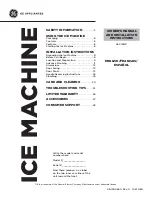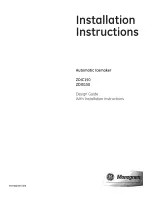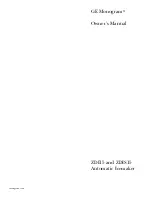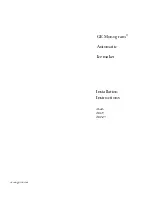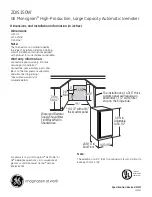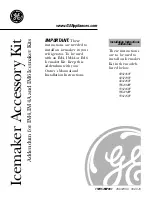
9
every calibration. Position near primary thermostat
(center) bulb is recommended.
4.
Pre-2000 model: If calibration of thermostat is found
to be less than 15°F(9.44°C) off, simply loosen
three dial plate retaining screws, rotate dial plate to
match thermometer reading and tighten screws.
2000-model: If calibration is found to be less than
15°F (9.44°C) off, remove thermostat knob. Loosen
four screws in thermostat dial plate. Replace knob.
Reset dial plate to match thermometer reading.
Remove knob to tighten screws on dial plate and
replace knob.
If the thermostat is more than 15°F(9.44°C) off then
a qualified service company must be contacted to
have the Pasta System properly calibrated.
Figure 4-2
Thermostat calibration (pre-2000 model shown)
Thermostat Calibration 2000 Model
(Thermostat knob removed to
reveal calibration screws.)
B. The Water Auto-Fill and Low Water Safety Shut-
Off Systems
The water supply connection, located at the bottom rear
of the Pasta System and marked water, is a standard
3
/
8
”
female pipe connection. The water pressure should be
between 20-60 psi. If the pressure exceeds 60 psi, a
pressure regulator must be used. The water
temperature must not exceed 150°F(65.6°C). Hot or
warm water is not needed due to the instant recovery of
the Pasta System.
Connections suitable for hot water must be used.
All connections must be tested for leaks before
using the Pasta System.
NOTE:
For Pasta Systems with casters, flexible hose
must be used to avoid leaking when the Pasta System
is moved for cleaning.
Control of the water level is fully automatic with the
auto-fill system. The water level is controlled by two
circuit boards and two sensors. The sensors are located
in the tube on the right side of the overflow deck. The
upper sensor controls the water level and the lower
sensor controls the low water safety shut-off system.
Once the water On/Off switch is turned on, the blue light
will come on and start to fill until the water level reaches
the upper sensor. The burners will not come on until the
water level reaches the lower sensor, preventing the
Pasta System from being damaged if there is little or no
water in it. Both sensors must be cleaned with the
sensor brush (like the one provided) on an hourly basis
or whenever starch foams up to maintain the proper
water level. Sensors must be cleaned more often in
areas with hard water, in installations with softened
water (due to the salt in the water) or when oil or salt is
placed in the water for cooking.
The brush must be checked on a regular basis and
replaced whenever it starts to wear.
Do not store the sensor brush in the sensor tube as
it could contact the sensors, which could allow the
water level to drop below the heat tubes and
damage the Pasta System.
Using a worn brush could damage the sensors.
NOTE:
Water level problems caused by the sensors
not being cleaned adequately will not be covered under
warranty.
WHEN THE WATER LEVEL FALLS BELOW THE
LOWER SENSOR THE BURNERS WILL SHUT OFF.
IF THEY STAY ON, TURN THE MAIN POWER
ON/OFF SWITCH TO THE “OFF” POSITION AND
CLEAN THE SENSORS THOROUGHLY. IF THE
PROBLEM STILL OCCURS, HAVE THE WATER
AUTO-FILL SYSTEM CHECKED BY A QUALIFIED
SERVICE TECHNICIAN.
Figure 4-3 Sensor Tube Location
Содержание INSTANT RECOVERY SERIES 2009
Страница 17: ...15 VII WIRING DIAGRAMS 14 ELECTRIC PASTA 2 THERMOSTAT WIRING DIAGRAM WITHOUT TIMERS 2...
Страница 18: ...14 ELECTRIC PASTA WITH DIGITAL TIMERS WIRING DIAGRAM 16...
Страница 19: ...17 14 ELECTRIC PASTA WITH 138 TIMERS WIRING DIAGRAM PRE 2000 SERIES BLACK DIAL TIMER NOT DIGITAL...
Страница 20: ...18 14 ELECTRIC PASTA WITH BASKET LIFT AND DIGITAL TIMERS WIRING DIAGRAM...
Страница 21: ...19 18 20 ELECTRIC PASTA WITH 138 TIMERS WIRING DIAGRAM PRE 2000 SERIES BLACK DIAL TIMER NOT DIGITAL...
Страница 22: ...20 18 ELECTRIC PASTA 2 THERMOSTAT WIRING DIAGRAM WITHOUT TIMERS...
Страница 23: ...21 24 ELECTRIC PASTA WITH DIGITAL TIMERS WIRING DIAGRAM...
Страница 24: ......


























